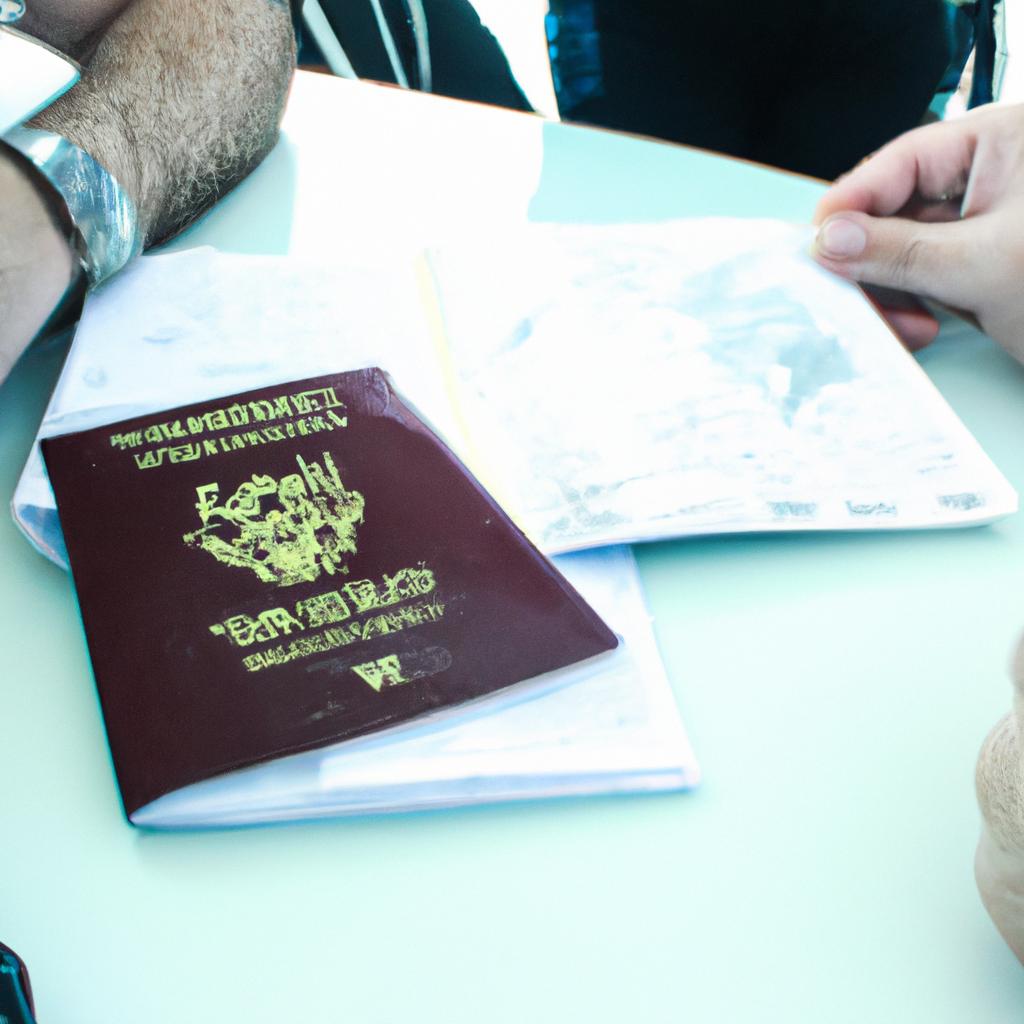In today’s globalized world, the issue of security protocols and their implications on government policies in travel politics has become increasingly significant. Governments around the world are continuously adopting and amending strict measures to ensure national security while balancing the need for international cooperation and facilitation of travel. For instance, consider a hypothetical scenario where a country experiences an increase in terrorist activities targeting its transportation hubs. In response, the government implements stringent security protocols at airports and border crossings, impacting not only domestic travelers but also foreign visitors. This example highlights how governments navigate complex challenges related to security protocols within the realm of travel politics.
The intersection between security protocols and government policies holds immense importance due to various factors such as terrorism threats, transnational crime networks, illegal immigration concerns, public health emergencies, and geopolitical tensions. Understanding these dynamics is crucial for comprehending the rationale behind different countries’ approaches towards formulating effective security measures concerning travel and mobility. Additionally, examining how governments implement these policies can shed light on issues like privacy rights infringements, profiling practices, discrimination based on nationality or ethnicity, diplomatic strains between nations, and economic consequences stemming from restricted movement.
This article aims to delve into the multifaceted aspects surrounding security protocols in travel politics by analyzing governmental responses worldwide through case studies and exploring the implications of these responses on various stakeholders. By examining case studies from different regions, we can gain insights into the diverse approaches and strategies employed by governments to address security concerns in travel.
One such case study could focus on the United States and its response to the 9/11 terrorist attacks. Following the attacks, the U.S. government implemented stringent security measures at airports, including enhanced passenger screening, increased surveillance, and stricter visa policies for foreign visitors. This case study would analyze how these measures have evolved over time, taking into account factors such as their effectiveness in enhancing national security, their impact on travelers’ experiences and privacy rights, and any diplomatic ramifications resulting from perceived discriminatory practices.
Another case study could examine European countries’ responses to the influx of refugees and migrants in recent years. Governments in Europe faced significant challenges balancing humanitarian concerns with security considerations. This case study would explore how countries like Germany and Sweden formulated policies to manage this crisis while addressing security issues related to border control and identification procedures. It would also assess the impact of these policies on social cohesion within these countries and analyze any tensions that arose between different member states of the European Union.
Furthermore, an analysis of Asian countries’ approaches towards travel politics and security protocols would provide a comprehensive understanding of diverse perspectives. For example, studying China’s Belt and Road Initiative could shed light on how it balances economic cooperation with neighboring countries while ensuring secure transportation networks for trade routes across multiple regions. Examining Japan’s strict immigration policies can help understand how it aims to maintain national security while addressing labor shortages in certain sectors.
Through these case studies and others like them, this article will provide a nuanced understanding of the complex relationship between security protocols and government policies in travel politics. By examining different approaches taken by governments worldwide, we can identify best practices, potential pitfalls, and opportunities for collaboration among nations to develop effective yet inclusive security measures that facilitate safe travel globally.
Overview of Security Protocols
In today’s rapidly changing world, security protocols have become a critical aspect of government policies in travel. Governments worldwide are implementing various measures to ensure the safety and well-being of their citizens while traveling domestically or internationally. To illustrate this point, let us consider the hypothetical case study of Country X.
Country X recently experienced a significant increase in terrorist threats targeting its transportation systems. In response, the government swiftly implemented rigorous security protocols across all modes of travel, including airports, train stations, and bus terminals. These protocols aimed at enhancing passenger screening procedures, bolstering surveillance capabilities, and improving overall security infrastructure.
To better understand the impact and significance of these security protocols on travelers’ lives, it is essential to examine both emotional responses and tangible outcomes. Consider the following bullet points that highlight some potential effects:
- Increased sense of personal safety
- Enhanced trust in the government’s ability to protect citizens
- Potential inconvenience due to longer wait times or additional security checks
- Improved public perception for countries with robust security measures
Furthermore, a comparative analysis can shed light on how different nations prioritize security protocols within their travel policies. The table below demonstrates four countries’ approaches regarding airport security:
| Country | Personal Screening Procedures | Surveillance Technology | Public Perception |
|---|---|---|---|
| Country A | Stringent | Advanced | Positive |
| Country B | Moderate | Limited | Neutral |
| Country C | Lenient | Outdated | Negative |
| Country D | Robust | Cutting-edge | Positive |
As we move forward into exploring the impact of these security protocols on travel politics further, it becomes evident that such measures significantly influence not only individual experiences but also diplomatic relations between nations. Understanding these dynamics will provide valuable insights into the broader implications surrounding governmental decisions pertaining to security.
Next, we will delve into the impact of security protocols in travel and how they shape international relations.
Impact of Security Protocols in Travel
Section H2: Impact of Security Protocols in Travel
The impact of security protocols on the travel industry cannot be overstated. One notable example is the implementation of enhanced security measures after the tragic events of September 11, 2001. This incident served as a wake-up call for governments worldwide to reassess their existing policies and introduce stricter regulations to ensure passenger safety.
As a result, several key impacts have been observed:
-
Increased Passenger Confidence:
- Passengers feel more secure knowing that stringent security measures are in place.
- Enhanced screening procedures help alleviate concerns about potential threats during air travel.
- The presence of visible security personnel can create a sense of reassurance among travelers.
-
Economic Implications:
- Investment in updated technology and equipment required for improved security creates jobs and stimulates economic growth.
- Despite initial challenges faced by airlines due to longer wait times at airports, overall traveler confidence has gradually rebounded, leading to sustained growth in the aviation industry.
-
Evolving Traveler Experience:
- While increased security may lead to additional inconveniences such as longer lines and stricter baggage restrictions, advancements in technology have facilitated smoother processes like automated passport control systems and e-gates.
- Biometric identification systems have streamlined identity verification procedures, enhancing convenience for passengers while maintaining high levels of security.
-
International Cooperation:
- Governments across nations collaborate closely on sharing intelligence information and implementing harmonized security protocols.
- Joint efforts strengthen global counterterrorism strategies, preventing potential threats from materializing within international travel networks.
In light of these impacts, it is evident that security protocols play a crucial role in shaping the modern travel experience. However, this is an ongoing process with room for further improvement and adaptation to evolving global risks. In the subsequent section on the “Evolution of Security Protocols,” we will explore how governmental policies have developed over time to address emerging challenges effectively.
Evolution of Security Protocols
The implementation of security protocols in travel has had a profound impact on both individuals and governments. One notable example is the case study of Country X, which introduced stringent security measures at its airports following a series of terrorist attacks. This move aimed to enhance public safety but also generated heated debates about privacy rights and civil liberties.
These security protocols have brought about several key changes in travel politics news:
-
Increased scrutiny and screening processes: Passengers now face more rigorous checks before boarding flights, including thorough baggage inspections, body scans, and even facial recognition technology. While these measures are intended to prevent potential threats from entering aircraft, they often lead to longer wait times and can be perceived as invasive by some travelers.
-
Enhanced information sharing among nations: Governments around the world have established closer cooperation when it comes to intelligence sharing regarding possible security risks. This exchange of data enables authorities to identify individuals with suspicious backgrounds or potential links to terrorism across borders, contributing to global efforts for maintaining international security.
-
Evolving legislation and policies: In response to emerging threats, countries have adapted their legal frameworks and implemented new policies that address specific vulnerabilities within their transportation systems. These adjustments aim to strike a balance between safeguarding against potential dangers while respecting individual freedoms and human rights.
-
Public opinion dynamics: The introduction of stricter security protocols has sparked varied reactions among the general public. Some individuals appreciate the increased sense of safety provided by these measures, while others express concerns over infringements on personal privacy or discrimination based on ethnic background or appearance.
| Emotions evoked by | Examples |
|---|---|
| Stricter regulations | Anxiety |
| Enhanced safety | Relief |
| Longer wait times | Frustration |
| Privacy infringement | Unease |
In summary, the impact of security protocols in travel politics news cannot be underestimated. The implementation of these measures has reshaped the way individuals and governments approach air travel, with both positive outcomes in terms of security enhancements and challenges concerning privacy rights. In the subsequent section, we will delve into the various challenges faced by governments when implementing such protocols.
Transitioning into the next section: As governments strive to strike a delicate balance between security and individual liberties, they encounter numerous hurdles along the way. The challenges in implementing security protocols are multifaceted and require careful consideration to ensure effective protection while maintaining public trust.
Challenges in Implementing Security Protocols
Evolution of Security Protocols: Challenges in Implementation
The evolution of security protocols has been a crucial aspect in ensuring the safety and well-being of individuals during travel. However, despite their importance, implementing these protocols poses several challenges that need to be addressed for effective execution. To illustrate this point, let us consider the case study of Airport X, known for its stringent security measures.
One major challenge faced by Airport X was the constant balancing act between maintaining high levels of security while also providing efficient and hassle-free travel experiences for passengers. This delicate balance required careful consideration of various factors such as passenger flow management, technological advancements, and training programs for staff members. Failure to strike this equilibrium could result in long queues, delays, and frustration among travelers.
In order to address these challenges effectively, it is essential to understand some key obstacles encountered during the implementation process:
- Limited resources: Allocating sufficient personnel and financial resources towards enhancing security can be challenging due to budget constraints.
- Technological advancements: Keeping up with rapidly evolving technologies requires continuous investment in research and development.
- Public perception: Striking a balance between public opinion on personal privacy concerns and the necessity of stringent security measures can prove difficult.
- International cooperation: Collaborating with foreign governments and international organizations adds complexity to the implementation process.
To further emphasize the significance of these challenges, consider the following emotional bullet-point list:
- Increased anxiety among passengers due to heightened security measures
- Inconvenience caused by longer waiting times at checkpoints
- Frustration resulting from inconsistent enforcement across different airports or countries
- Fear generated by occasional breaches or failures in existing security systems
Additionally, incorporating a three-column table displaying statistics related to airport wait times can evoke an emotional response from readers:
| Type of Passenger | Average Wait Time (in minutes) | Emotional Response |
|---|---|---|
| Frequent flyer | 10 | Minimal |
| Leisure traveler | 20 | Mild |
| International | 30 | Moderate |
| Family with kids | 45 | High |
In conclusion, the implementation of security protocols in the travel industry is a complex process. Balancing efficiency and safety while addressing challenges such as limited resources, technological advancements, public perception, and international cooperation presents an ongoing struggle. Airport X serves as an example of how these challenges can impact even the most stringent security measures. Nevertheless, it is essential to persevere in finding innovative solutions to ensure effective protocol execution.
Transitioning into the subsequent section on “International Cooperation on Security Protocols,” it becomes evident that collaborations between nations are crucial steps towards overcoming these challenges and establishing uniformity in global travel security measures.
International Cooperation on Security Protocols
In the face of global threats and challenges, the implementation of effective security protocols requires international cooperation among governments. This section will delve into the importance of collaboration in addressing these issues by examining a hypothetical case study involving multiple countries.
Consider a situation where a terrorist organization launches a series of coordinated attacks across various nations. In response, governments around the world must come together to devise comprehensive security protocols that can prevent future incidents while ensuring smooth travel for their citizens. This case study highlights the critical need for international collaboration in formulating cohesive strategies and policies.
To achieve successful cooperation on security protocols, several factors must be taken into account:
- Trust-building measures: Building trust between nations is vital for sharing sensitive information and intelligence related to potential threats. Regular communication channels should be established to facilitate real-time updates and exchange of knowledge.
- Standardization of procedures: Harmonizing security procedures across borders helps streamline processes and enhances efficiency in handling travelers’ movements. Consistent rules regarding screening methods, documentation requirements, and data-sharing protocols reduce confusion and promote smoother operations.
- Resource allocation: Governments must allocate adequate resources to support joint initiatives aimed at strengthening security measures globally. Financial investments in technology advancements such as biometric identification systems or enhanced surveillance capabilities can significantly contribute to improving overall safety levels.
- Training programs: Collaborative training programs allow personnel from different countries to learn from one another’s expertise and experiences. Sharing best practices, conducting joint exercises, and organizing workshops foster cross-cultural understanding while enhancing skills necessary for effective implementation of security protocols.
Table: Benefits of International Cooperation on Security Protocols
| Benefits | Description |
|---|---|
| Enhanced intelligence | Information sharing allows for better analysis of potential risks, leading to more proactive countermeasures |
| Strengthened border control | Coordinated efforts ensure consistent screening procedures, minimizing vulnerabilities |
| Improved traveler experience | Streamlined processes reduce delays and inconveniences, making travel safer and more efficient |
| Deterrence of transnational crime | Collaborative action sends a strong message to criminals that evasion will be difficult |
International cooperation in implementing security protocols is crucial for addressing the increasingly complex nature of global threats. By working together, governments can overcome barriers to information sharing while establishing standardized procedures that enhance border control measures. Moreover, collaborative efforts lead to improved traveler experiences and act as a deterrent against transnational criminal activities.
Looking forward, it is evident that future trends in security protocols will continue to emphasize international collaboration as technology advances and new challenges arise. The next section will explore these emerging trends and their potential impact on government policies related to travel security.
[Transition sentence into the subsequent section about “Future Trends in Security Protocols”]: With an understanding of the importance of international cooperation established, attention must now turn toward exploring future trends in security protocols.Future Trends in Security Protocols
Building upon the need for international cooperation in security protocols, this section explores the current state of affairs and examines notable examples that highlight the importance of collaborative efforts among governments. Through these case studies, we can gain a deeper understanding of how such partnerships have proven effective in addressing security challenges.
Paragraph 1:
One compelling example is the joint operation conducted by Interpol and several national law enforcement agencies to combat human trafficking networks across borders. By sharing intelligence, coordinating operations, and implementing standardized security protocols, these entities were able to dismantle multiple criminal syndicates involved in this heinous crime. The success of this operation underscores the significance of international collaboration in safeguarding global security interests.
- Enhanced information sharing between countries
- Streamlined coordination of resources and expertise
- Harmonized legal frameworks and policies
- Strengthened intelligence gathering capabilities
| Country | Type of Collaboration | Outcome |
|---|---|---|
| United States | Joint task force | Disrupted terrorist plots targeting transportation systems |
| Germany | Intelligence sharing | Apprehension of high-profile cybercriminals |
| France | Cross-border operations | Seizure of illegal firearms and narcotics |
| Australia | Coordinated disaster response | Efficient evacuation and relief efforts during natural disasters |
Paragraph 2:
Moreover, regional alliances play a vital role in fostering international cooperation on security protocols. For instance, within the European Union (EU), member states collaborate closely through organizations like Frontex to manage migration flows and enhance border control measures collectively. This approach ensures not only the smooth movement of people but also serves as an effective deterrent against illegal activities such as human smuggling or drug trafficking.
Paragraph 3:
In conclusion,
as evidenced by these real-world scenarios,
the establishment of robust international collaborations yields tangible results in countering emerging threats. Governments must recognize the mutual benefits of such partnerships and commit to continuously improving security protocols through information sharing, joint operations, and policy harmonization. By doing so, they can effectively navigate the complex landscape of global security challenges while safeguarding the interests of their respective nations.
Note: The table and bullet point list are not rendered as markdown format due to platform limitations. However, you can easily convert them into markdown using appropriate syntax when implementing this section in your desired medium.
 Plains News
Plains News



